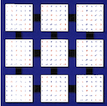1 SUBROUTINE pdlauum( UPLO, N, A, IA, JA, DESCA )
14 DOUBLE PRECISION A( * )
120 INTEGER BLOCK_CYCLIC_2D, CSRC_, CTXT_, DLEN_, DTYPE_,
121 $ LLD_, MB_, M_, NB_, N_, RSRC_
122 parameter( block_cyclic_2d = 1, dlen_ = 9, dtype_ = 1,
123 $ ctxt_ = 2, m_ = 3, n_ = 4, mb_ = 5, nb_ = 6,
124 $ rsrc_ = 7, csrc_ = 8, lld_ = 9 )
126 parameter( one = 1.0d+0 )
132 EXTERNAL pdgemm,
pdlauu2, pdtrmm, pdsyrk
137 EXTERNAL iceil, lsame
149 jn =
min( iceil( ja, desca( nb_ ) ) * desca( nb_ ), ja+n-1 )
150 IF( lsame( uplo,
'U' ) )
THEN
157 CALL pdlauu2(
'Upper', jb, a, ia, ja, desca )
159 CALL pdsyrk(
'Upper',
'No transpose', jb, n-jb, one, a, ia,
160 $ ja+jb, desca, one, a, ia, ja, desca )
165 DO 10 j = jn+1, ja+n-1, desca( nb_ )
166 jb =
min( n-j+ja, desca( nb_ ) )
168 CALL pdtrmm(
'Right',
'Upper',
'Transpose',
'Non-unit',
169 $ j-ja, jb, one, a, i, j, desca, a, ia, j,
171 CALL pdlauu2(
'Upper', jb, a, i, j, desca )
172 IF( j+jb.LE.ja+n-1 )
THEN
173 CALL pdgemm(
'No transpose',
'Transpose', j-ja, jb,
174 $ n-j-jb+ja, one, a, ia, j+jb, desca, a, i,
175 $ j+jb, desca, one, a, ia, j, desca )
176 CALL pdsyrk(
'Upper',
'No transpose', jb, n-j-jb+ja, one,
177 $ a, i, j+jb, desca, one, a, i, j, desca )
187 CALL pdlauu2(
'Lower', jb, a, ia, ja, desca )
189 CALL pdsyrk(
'Lower',
'Transpose', jb, n-jb, one, a, ia+jb,
190 $ ja, desca, one, a, ia, ja, desca )
195 DO 20 j = jn+1, ja+n-1, desca( nb_ )
196 jb =
min( n-j+ja, desca( nb_ ) )
198 CALL pdtrmm(
'Left',
'Lower',
'Transpose',
'Non-unit', jb,
199 $ j-ja, one, a, i, j, desca, a, i, ja, desca )
200 CALL pdlauu2(
'Lower', jb, a, i, j, desca )
201 IF( j+jb.LE.ja+n-1 )
THEN
202 CALL pdgemm(
'Transpose',
'No transpose', jb, j-ja,
203 $ n-j-jb+ja, one, a, i+jb, j, desca, a, i+jb,
204 $ ja, desca, one, a, i, ja, desca )
205 CALL pdsyrk(
'Lower',
'Transpose', jb, n-j-jb+ja, one,
206 $ a, i+jb, j, desca, one, a, i, j, desca )

